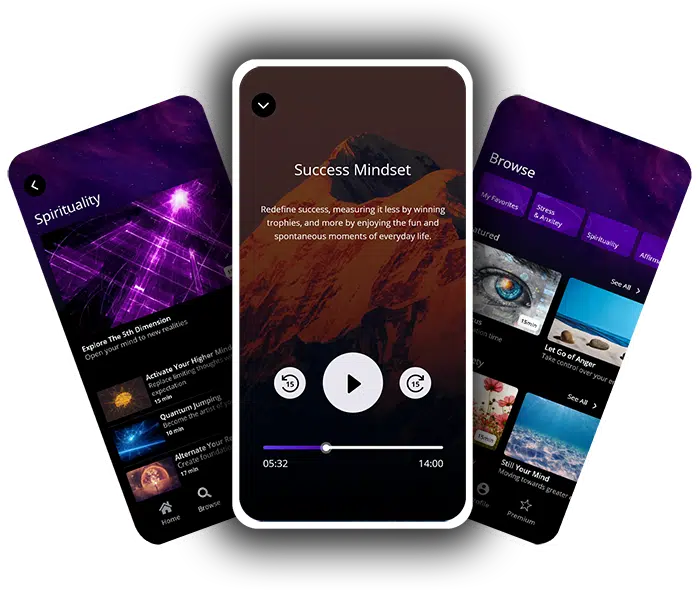Feeling stressed or can’t sleep? You’re not alone. The 4-7-8 breathing technique is a simple practice that helps calm your mind. This guide teaches you how to use it for relaxation and better sleep.
Ready to feel more at peace? Keep reading.

Unleash Your True Potential!
Explore the world of meditation with our powerful guided sessions crafted to bring peace and strength to your spirit.
But first, let’s ensure our sessions are the perfect fit for you.
Take our short quiz to find out!
Table of contents
Understanding the 4-7-8 Breathing Technique
The 4-7-8 breathing technique comes from ancient yogic practices called pranayama. It’s a simple exercise where you inhale for 4 seconds, hold your breath for 7 seconds, and exhale slowly for 8 seconds.
This method is all about bringing calmness to your mind and body. It’s like hitting the reset button on your stress levels.
Dr. Andrew Weil, a Harvard-trained expert in integrative medicine, helped make this breathing exercise famous. He says it can deeply relax you and even help with managing anxiety and stress by regulating cortisol—the hormone that goes wild when we’re under pressure.
People practicing mindfulness meditation or seeking personal growth love how easy yet powerful it is for promoting relaxation and improving mental health without needing any special tools or environments.

Unleash Your True Potential!
Explore the world of meditation with our powerful guided sessions crafted to bring peace and strength to your spirit.
But first, let’s ensure our sessions are the perfect fit for you.
Take our short quiz to find out!
How to Practice the 4-7-8 Breathing Technique
Now that we’ve explored what the 4-7-8 breathing technique is all about, let’s dive into how you can practice it. This simple method could be your next step towards better mental health and relaxation. Here’s a step-by-step guide to get you started:
- Find a comfortable place to sit or lie down. Make sure your back is straight but not stiff.
- Close your eyes gently. Feel any tension melting away from your body.
- Place the tip of your tongue against the tissue just behind your upper front teeth. Keep it there through entire exercise.
- Exhale completely through your mouth, making whoosh sound. This prepares you for the inhalation phase.
- Inhale quietly through your nose for four counts. Imagine drawing breath deep into your lungs.
- Hold that breath for seven counts. No need to clamp down hard—just prevent air from coming in or out easily.
- Exhale completely through the mouth at count of eight, again making a gentle whoosh sound as you release air.
- Repeat this cycle four times when starting out. With practice, work up to eight repetitions.
The Impact of Deep, Slow Breathing on Your Body
Deep, slow breathing does wonders for your body. It kicks off autonomic changes that boost heart rate variability and respiratory sinus arrhythmia. This means breathing deeply and slowly can make your heart and breathing rhythms more flexible.
These changes are key to calming down the fight or flight response triggered by stressors. They flip the switch on your nervous system, dialing up relaxation while turning down stress.
This type of breathing also affects how you feel pain and manage it. By focusing on your breath, sending air slowly through your lungs, you’re essentially telling your body to take it easy, easing pain perception.
Practices like the 4-7-8 technique fold seamlessly into yoga and meditation routines, reinforcing their benefits across physical and mental health spheres. Let’s explore how this simple technique might just be what you need to slash stress levels and improve sleep quality next.
Potential Benefits of the 4-7-8 Breathing Technique
The 4-7-8 breathing technique can help reduce stress and anxiety, promoting a sense of calmness and relaxation. It has potential to enhance sleep quality, aiding in achieving more restful and rejuvenating night’s sleep.
Reducing Stress and Anxiety
The 4-7-8 breathing technique can play a significant role in reducing stress and anxiety. It has the potential to activate the parasympathetic nervous system, helping to bring sense of calm and relaxation amidst daily pressures.
Frequent practice reportedly enhances its effectiveness in managing stress and anxiety, providing a practical tool for those seeking relief from these common challenges.
By incorporating the 4-7-8 breathing technique into your routine, you may discover a powerful ally in combating stress and anxiety. This simple yet impactful practice offers an accessible way to tap into feelings of calmness and balance whenever they are needed most.
Enhancing Sleep Quality
Now, let’s delve into how practicing the 4-7-8 breathing technique can enhance your sleep quality. This calming exercise has shown potential in helping individuals feel more serene, promoting better sleep patterns and improved digestion.
Incorporating this method into your bedtime routine may aid in easing anxiety and setting the stage for a restful night’s sleep.
Training the Body to Better Respond to Stress
The 4-7-8 breathing technique trains the body to manage stress better. It helps regulate cortisol, the hormone responsible for stress, and induces a calming effect on the mind and body.
This technique can also reduce anxiety, promote relaxation, and assist in enhancing sleep quality.
By practicing this technique regularly, you can effectively condition your body to respond more calmly to stressful situations. Slow and deep breathing triggers the brain’s relaxation response, making it an invaluable tool for those seeking personal growth and spiritual well-being.
Tips to Master the 4-7-8 Breathing Technique
- Tips to Master the 4-7-8 Breathing Technique
- Inhale through your nose for count of 4, allowing your belly to rise as you take in air deeply.
- Hold your breath for a slow count of 7, maintaining calm and steady composure while doing so.
- Exhale slowly for a count of 8, releasing the air from your lungs completely and letting go of any tension or stress.
- Practice this technique regularly to train your body and mind to respond more effectively to stressors and promote relaxation.
- Find a quiet and comfortable space where you can fully concentrate on the rhythm of your breath during each session.
- Gradually increase the duration of each phase as you become more adept at the technique, aiming for deeper inhalations, longer pauses, and slower exhalations.
Easier Alternative to 4-7-8 Breathing Exercise
Having mastered the 4-7-8 breathing technique, you might be curious about easier alternatives. Consider exploring the Wim Hof breathing method, which offers a different approach to enhancing your well-being through breathwork.
This alternative health practice incorporates distinctive breathing exercises that can further enrich your spiritual journey and personal growth.
Conclusion
In conclusion, mastering the 4-7-8 breathing technique offers numerous benefits for your well-being. The deep, slow breaths can help reduce stress and anxiety, improve sleep quality, and train your body to better respond to stress.
By incorporating this ancient yogic practice into your routine, you can enhance your overall physical and mental wellness. With focused practice and dedication, you will soon experience the transformative power of this simple yet effective breathing technique.
FAQs
What is 4-7-8 breathing technique, and how can it help me?
The 4-7-8 breathing exercise is a very simple yet powerful relaxation method that involves inhaling for 4 second, holding your breath for 7 second, and exhaling for 8 second. This technique helps manage anxiety, improve sleep, and lower blood pressure by calming the mind and body.
Can practicing the 4-7-8 technique reduce my stress levels?
Absolutely! By focusing on deep abdominal breathing and following the specific rhythm of the 4-7-8 exercise, you activate your body’s rest-and-digest response. This counters stress and encourages a state of calmness—helping to melt away tension.
Is this breathing exercise suitable for everyone?
While most people find the 478 breathing exercise beneficial—especially those dealing with anxiety or trouble sleeping. it’s wise to consult medical professional if you have conditions. For example, chronic obstructive pulmonary disease (COPD). They can guide you on safely incorporating it into your wellness routine.
How often should I do this breathing technique for maximum benefits?
For starters, try practicing twice daily to get familiar with the pattern. As you become more comfortable, use it whenever you feel anxious or stressed out during the day—or right before bed if insomnia troubles you. Consistency is key!
Besides reducing stress, what other benefits does this practice offer?
Beyond easing stress responses—the yoga-inspired breathing exercise also supports mood regulation, decreases feelings of depression or anger through mindful engagement with your breath control process—and may even assist in managing high blood pressure over time.
Where can I learn more about effective relaxation techniques like this one?
Plenty of resources are available—from guided imagery videos online to counseling sessions with psychologists specializing in emotion regulation strategies. For example, progressive muscle relaxation or bhramari (yoga) breathing techniques—offering insights into achieving better mental health care through self-regulation practices.










